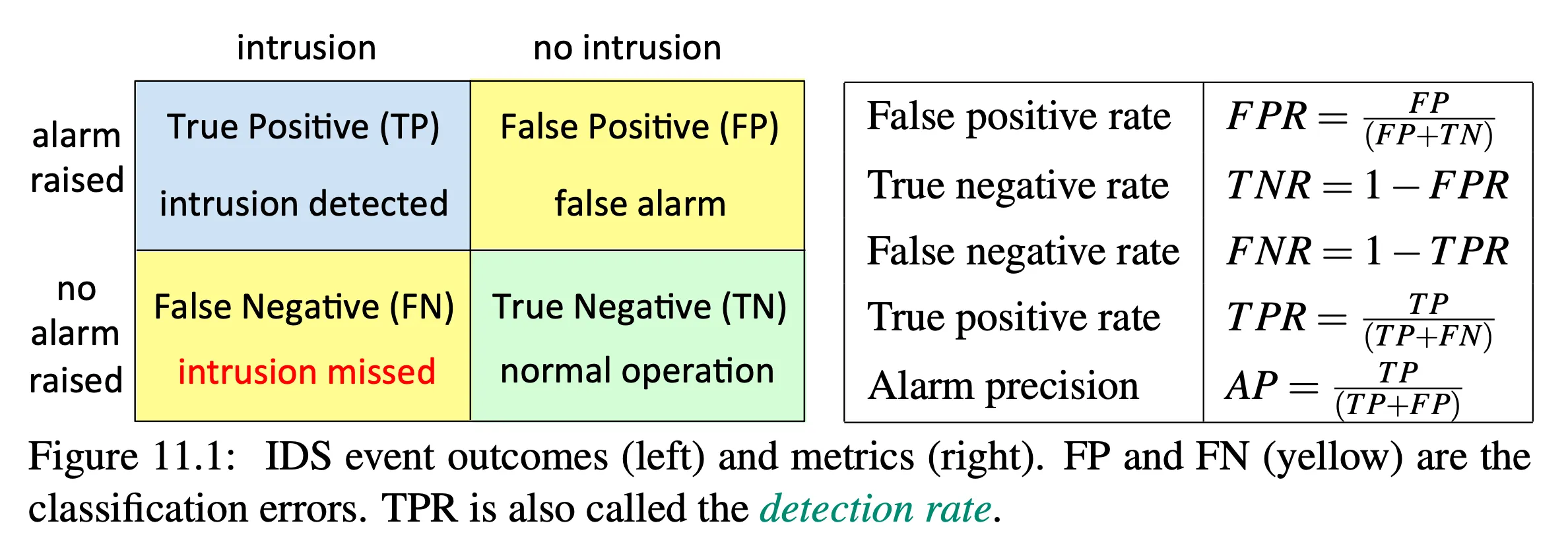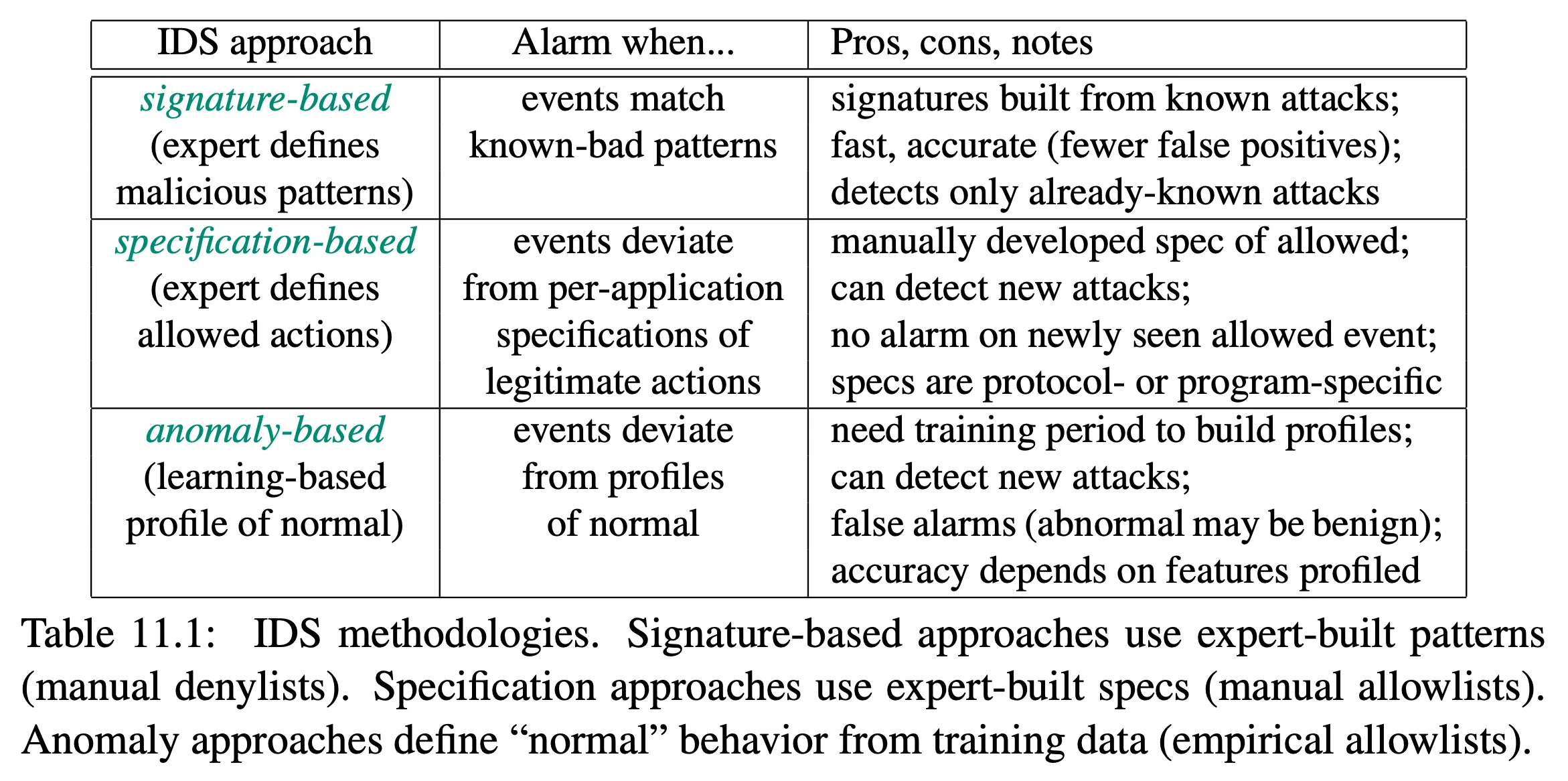Intrusion detection and scanners
Questions on the readings
The readings today are from Computer Security and the Internet, Chapter 10, sections 11.0 - 11.3.
Intrusion detection
-
try to identify unauthorized or malicious traffic
-
intrusion detection system
- monitors events
- logs related data
- analyzes data
- reports events requiring human attention
-
intrusion prevention system
- includes active responses
- alter packets, strip out malware, reset TCP connections, terminate processes
- real-time
-
may monitor processes, programs, commands, data at rest, network packets
-
need to collect evidence for a forensic process
-
network-based IDS
- examines packets, e.g. at a router
-
host-based IDS
- examines events on a system, such as application logs, filesystem changes, system calls, CPU usage

-
true positive, false positive (false alarm)
-
true negative, false negative (intrusion missed)
-
example
- imagine we have 100 packets that are OK
- if system has a false positive for 1 out of 100, then FPR = 1/100 = 1%
- we could say this system is 99% accurate
- imagine that out of 100,000 packets we expect 1 to be malicious
- given FPR of 1%, then there will be 1,000 false positives and 1 true positive
- would you now say the system is 99% accurate?
- precision = TP/(TP + FP) = 1/(1,000 + 1) = 0.1%
- 99.9% of alarms are false alarms
- exploring false alarms steals expert time
- imagine we have 100 packets that are OK
Approaches to intrusion detection

- signature-based
- signatures usually automatically updated from vendor
- may look at behavior (effects of the attack) as well
- specification-based
- define what is allowed for a protocol or application
- anomaly-based
- measure normal behavior
- classify anything else as an anomaly
- often uses machine learning
- challenges
- feature selection
- intruder-free training
- session creep (intruders slowly adding themselves)
Sniffers
- to look at network traffic, need to capture packets and examine them at line speed
- helpful even outside of intrusion detection
- also used by attackers!

-
because a hub broadcasts traffic, every host on the LAN sees all the traffic
-
network cards can be put into promiscuous mode to sniff traffic
Vulnerability assessment tools
-
explore weaknesses in your systems so that you can modify / update them for increased security
- vulnerability assessment — examines systems for vulnerability
- penetration testing — tries to exploit a vulnerability
- can be used for both defense and offense
-
make sure you get authorization to do any kind of vulnerabilty assessment or penetration testing
-
make sure you follow responsible disclosure when finding a vulnerability
- see below
-
port scanning is a common assessment tool
-
remote OS fingerprint is also a common assessment tool
-
some of what
nmapcan do:- finding IP addresses of live hosts within a target network;
- OS classification of each live host (OS fingerprinting, above);
- identifying open ports on each live host (port scanning);
- version detection (for open ports, identifying the service listening, and version)
- network mapping (building a network topology—hosts and how they are connected)
-
some of what
Nessuscan do:- remote vulnerability scanning
- has a library of CVEs it checks for
Vulnerability disclosure process
-
USENIX Security 2025 ethics statement regarding vulnerability disclosure:
Disclosures. Vulnerabilities, if known to adversaries, can expose people to negative outcomes, such as harms or rights violations. Publicly disclosing vulnerabilities before they have been privately disclosed to the responsible parties, and hence before they have been mitigated, can therefore expose people to negative outcomes. Adversaries or others can also independently discover vulnerabilities. The potential for independent adversary discovery means that knowing about vulnerabilities but not disclosing them to the responsible parties can also result in exposing people to negative outcomes. Additionally, in some cases it can take the responsible parties time to develop mitigations. Therefore, once a vulnerability has been discovered, it is important to initiate the mitigation process as early as possible. Specifically, absent strong and convincing reasons otherwise, we expect researchers to disclose vulnerabilities as soon as they are discovered. If the researchers believe that a different timeline is the most ethical in their situation, they should present clear and convincing arguments for that different timeline. The arguments should clearly articulate why a delayed disclosure is in the best interest of users or people in general, e.g., most supportive of these people’s wellbeing or least likely to violate their rights. Submissions that fail to disclose prior to submission and that do not present convincing ethical arguments for delaying disclosure may be rejected or may receive a revision decision.
Often, the most direct path for vulnerability mitigation is to disclose the vulnerability to the responsible party, e.g. the manufacturer. In some cases, for example when the vulnerability is widespread or the mitigation process involves coordination with many organizations, the most ethical course of action may be to leverage organizations that coordinate vulnerability disclosure, such as the CISA in the United States, rather than or in addition to disclosing to affected parties directly.
Extra Reading
-
99% False Positives: A Qualitative Study of SOC Analysts’ Perspectives on Security Alarms — interviews with analysts, discussing burnout from false alarms, with most alarms caused by legitimate behavior.
-
Matched and Mismatched SOCs: A Qualitative Study on Security Operations Center Issues — interview study with analysts identifying a wide range of technical and non-technical issues in SOCs.
-
Watch Can Vulnerability Disclosure Processes Be Responsible, Rational, and Effective?